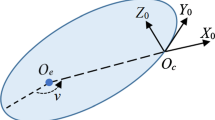Abstract
The gyroscopic motion of a spin-stabilized satellite due to gravity gradient torques in a circular orbit has been analyzed to varying degrees in numerous publications. This paper shows that the restriction to a circular orbit is, in fact, not essential and with a slight increase in complexity, noncircular orbits may be treated. More importantly, a uniform regression of the orbital node can also be accounted for. The general results are expressed in closed form using Jacobian elliptic functions. Finally, and this is perhaps most important, certain algebraic integrals of the precession are given which can be used to place limits on the excursions of the spin axis without actually solving for the motion. This allows one to design orientations such that the maximum angle between the orbit normal and spin axis never exceeds a specific amount even though the orbit normal is in precession.
Similar content being viewed by others
Abbreviations
- Symbol :
-
Definition
- A :
-
distance between symmetry axes of two parabolas
- a i ,b i ,c i :
-
coefficients in quadratics
- C :
-
integration constant
- D orD i :
-
discriminant
- e :
-
eccentricity
- i :
-
inclination (also subscripting index)
- I 1,I 2 :
-
longitudinal and transverse moments of inertia
- J 2 :
-
second zonal harmonic coefficient
- K :
-
parameter in Jacobian Elliptic Functions
- L:
-
angular momentum vector
- n :
-
mean motion ≡\(\sqrt {{\mu \mathord{\left/ {\vphantom {\mu {a^3 }}} \right. \kern-\nulldelimiterspace} {a^3 }}} \)
- N:
-
unit vector normal to the orbit plane
- p :
-
semi-latus rectum
- P:
-
normalized radius vector (unit vector from center of force to body)
- Q, Q i :
-
quadratics
- r :
-
radius
- R :
-
fourth degree polynomial
- S:
-
unit vector along spin axis
- S 1 ,S 2 ,S 3 :
-
components ofS
- t, t 0 :
-
time
- u :
-
a parameter
- u i :
-
roots of quadratic equations
- v :
-
integration (dummy) variable
- αi :
-
roots of quadratic equations
- η:
-
a time scale constant
- θ:
-
angle between spin axis and orbit normal
- K :
-
maximum precession rate=3n 2(I 2 /I 1 −1)/2ω(1−e 2)3/2
- λi :
-
coefficients (functions ofu i )
- μ:
-
gravitational constant
- π:
-
spin axis pression rate (π=K cosθ)
- τ:
-
torque
- ϕ:
-
integration (dummy) variable
- ω:
-
spin rate (angular velocity)
- Ω:
-
angular velocity of precession
- Ω1, Ω2, Ω3 :
-
components of Ω
- am (u¦k):
-
Legendre's amplitude function
- sn (u¦k):
-
a Jacobian Elliptic function (generalization of sine)
- cn (u¦k):
-
complementary Jacobian elliptic function (analogous to the cosine)
References
Garber, T. B.: 1962,The Precession of Spinning Bodies Due to Gravitational Gradient Torques, Rand Corporation, Memorandum RM-3191-PR.
Grasshoff, L. H.: 1960,Influence of Gravity on Satellite Spin Axis Altitude, ARS Journal, pp. 1174–1175.
Handbook of Mathematical Functions, National Bureau of Standards, Applied Mathematics Series, 55, August 1966.
Routh, E. J.: 1955,Dyamics of a System of Rigid Bodies, Part II, 6th Revision, Dover Publishers.
Author information
Authors and Affiliations
Additional information
Actron, a Division of Mc Donnell Douglas Corporation
Rights and permissions
About this article
Cite this article
Dvornychenko, V.N., Gerding, R.B. The effect of orbital eccentricity and nodal regression on spin-stabilized satellites. Celestial Mechanics 16, 263–274 (1977). https://doi.org/10.1007/BF01232654
Received:
Issue Date:
DOI: https://doi.org/10.1007/BF01232654




